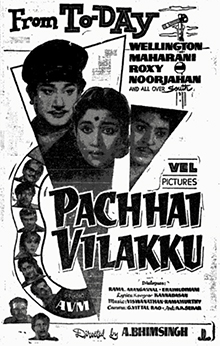Top Qs
Timeline
Chat
Perspective
Pachhai Vilakku (1964 film)
1964 film by A. Bhimsingh From Wikipedia, the free encyclopedia
Remove ads
Pachhai Vilakku (transl. Green Light) is a 1964 Indian Tamil-language drama film, directed by A. Bhimsingh and produced by Rama. Arangannal, A. R. Hassan Khan and T. S. Aadhi Narayanan. The film stars Sivaji Ganesan, C. R. Vijayakumari, S. S. Rajendran and S. V. Ranga Rao. It was released on 3 April 1964,[1] and became a box-office success, running for over 100 days in theatres.
Remove ads
Plot
This article needs a plot summary. (May 2021) |
Cast
- Sivaji Ganesan as Sarathy
- Sowcar Janaki as Parvathi
- S. S. Rajendran as Pasupathy
- C. R. Vijayakumari as Sumathi
- A. V. M. Rajan as Mani
- Pushpalatha as Latha
- S. V. Ranga Rao as Ponnambalam
- M. R. Radha as Rajabaadhar
- Nagesh as Joseph
- V. Nagayya as Gopalaiya
- S. R. Janaki as Annammal
- K. K. Soundar as Balu's henchman
- Sriram as Balu
- Karuppu Subbiah as Karim
Production
Saravanan who was doing a film on engine driver was on search of suitable title while crossing railway gate at T. Nagar.[2][3] He stuck posters with green light as main feature in a wall near the railway gate which led Bhimsingh to name his film as Pachhai Vilakku.[4] The film was initially shot in 8,000 feet (2,400 m) which left Meiyappan unimpressed and decided to reshoot with different story on the same backdrop with the additional cast involving Rajan and Pushpalatha.[2][5]
Soundtrack
The music was composed by Viswanathan–Ramamoorthy and lyrics for the songs were written by Kannadasan.[6] The songs "Olimayamaana Ethirkaalam" and "Kelvi Pirandhadhu" attained popularity.[2][5]
Remove ads
Release and reception
Pachhai Vilakku was released on 3 April 1964.[7] The Indian Express called it "a frothy, headlong musical melodrama, designed only to entertain."[8] P. S. Mani of Kalki gave the film a positive review, primarily for the cinematography and audiography.[9] T. M. Ramachandran of Sport and Pastime praised the cast performances, particularly Ganesan's, but called the story unreal although he praised the location photography of the train sequences and railway yard.[10] The film ran for over 100 days in theatres.[11][12]
Remove ads
References
Bibliography
External links
Wikiwand - on
Seamless Wikipedia browsing. On steroids.
Remove ads

